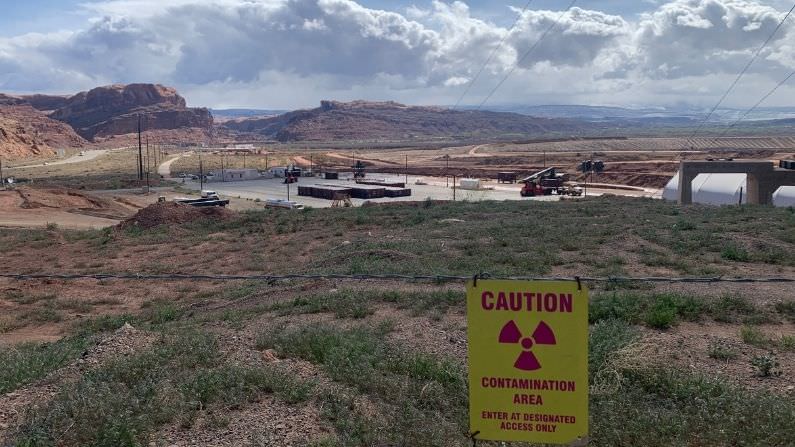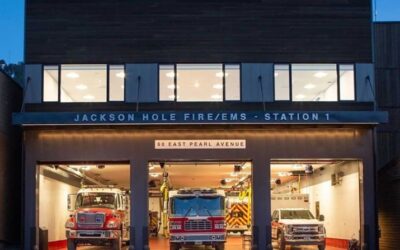This story comes to KHOL through the Rocky Mountain Community Radio coalition.
On any given afternoon, the sounds of trucks hauling material from the Moab Uranium Mill Tailings Remedial Action Project echo off the red rock cliffs on the banks of the Colorado River.
The U.S. Department of Energy is cleaning up around 16 million tons of uranium tailings here–waste from the former Atlas uranium-ore processing facility.
Uranium created a lot of wealth in this region while helping the country build its nuclear arsenal during the Cold War. But it came at a price, like these radioactive tailings. And it’s not only the landscape that was left scarred.
“My father was a former underground uranium miner. He died at the age of 44 years old from lung cancer,” said Phil Harrison Jr., who also worked in a uranium mine while in high school. He founded the Navajo Uranium Radiation Victims Committee in the late ’70s.
Many uranium mines and mills were on the Navajo Nation or used Navajo workers—like Harrison’s father. He said not all of his five siblings got to know him.
“The last three, they didn’t know their father,” said Harrison. “Typical of all the former Navajo uranium workers.”
He said he’s recorded over 400 former uranium workers in his northeastern Arizona community who have died of lung disease.
“So, we have over 400 widows and we have children that didn’t know their father. They didn’t know their grandfather. So, it’s very discouraging, you know, when you go out to my community. There’s hardly anyone around these days,” said Harrison.
Harrison has been helping to push legislation to help those impacted by the nuclear industry for decades. He advocated for the Radiation Exposure Compensation Act passed in 1990, which provided flat sums to some uranium mine workers. And he said he helped draft the amended version in 2000 which expanded help for downwinders—those who were exposed to fallout from nuclear testing.
Mary Dickson thinks that’s her.
“It started because I was diagnosed with thyroid cancer, which is one of the cancers that is pretty common from radiation exposure. I was only 29,” she said. Doctors removed her thyroid and then treated her with more radiation.
“You drank radioactive iodine to destroy any remaining thyroid tissue. So, I had on my hospital bracelet a little emblem that said ‘Caution: radioactive material,’” said Dickson.
A doctor would come to her door and hold up a Geiger counter every day until her radiation reading dropped. When she left the hospital she was told to avoid pregnant women and to not share a bed with her husband for a time.
“Nothing makes you an activist faster than a diagnosis, I always say,” Dickson explained.
Dickson said that fallout from nuclear detonations spread much farther than originally thought. The government set off nearly 1,000 atomic bombs at the Nevada Test Site. And a 1997 study by the National Cancer Institute said that nearly every state experienced some fallout from that testing. It estimates the detonations caused tens of thousands of cases of thyroid cancer around the country.
“That Cold War had casualties and still has casualties. People are still getting sick,” she said.
Dickson has also been working on expanding RECA for around 30 years. She was never eligible for benefits because her northern Utah county wasn’t covered under the downwinder provision. Another issue she wants fixed: RECA only covers those working in mines and mills before 1972.
Linda Evers, for example, can’t receive benefits because she started working in a uranium mill in 1976.
“I started on the labor gang in the mill which was 90 days of do whatever they needed done. Stuff like shoveling chutes out or scraping the acid tank out or cleaning the yellowcake filters. We just worked everywhere,” said Evers.
She was only 18 when she started. She said she went on to work on the “crusher,” which is part of the process to leach yellowcake from the ore.
“Well, I guess it was four and a half years and I got pregnant with my first child that was born in ’79 with birth defects that had to be repaired by the time he was two months old,” said Evers.
She went back to work for a different company but doing similar work. And then she was off to have her second child—also born with birth defects. She didn’t link the malformations to the mill.
“We weren’t told at all at any time how radiated we were getting. I had worked out there a couple of years before I ever saw a radon monitoring tag put in my hard hat,” Evers said.
In the years she worked there she said the company only once collected those tags, which detect how much radiation workers were receiving. But she thinks the owners and regulators knew the risks to workers’ health.
“The problem is the protective gear is so expensive and when you’re running massive amounts of workers though you can’t give every one of them a radiation suit because what if he only pans out for a couple of weeks. You wasted all that money,” she said.
Evers thinks the radiation that harmed her children also gave her breast cancer and a degenerative bone disease.
She helped found the Post ’71 Uranium Workers Committee and headed around the country to survey workers like herself, collecting data from Utah to Tennessee. But she felt ignored by Washington.
The current RECA expires in July. But there is an expanded act in Congress. Evers said that it’s crucial for survivors that politicians pass it. The bill would extend benefits for another 19 years and include post-‘71 workers like herself.
“It allows us to get the medical care that we need. Your regular family primary health care doesn’t really know how to treat lungs that are scarred from radiation damage,” Evers said.
She has to travel to Albuquerque for specialty care. Her Medicare doesn’t cover the expenses.
“We were told every day we were doing our part to keep America safe. We were told [that] every day. So, these people are patriotic—very, very patriotic people. We feel like we’ve already given our lives for this country,” Evers said.
Harrison on the Navajo Nation is trying to file as many claims as possible in the next two months before the act expires. Recently he was helping a former miner with lung disease who lived in a rural part of the reservation. In those remote areas it can be hard to get something as basic as a diagnosis letter, he said.
“After four months I finally got that diagnosis letter. So, I was able to help put a claim together. I sent it in. He received a notice a week after he died that his claim was approved,” Harrison said.
He said the pandemic hit those on the Navajo Nation with respiratory illness especially hard. He lost many former workers that could have received benefits.
“I feel that the government has done a lot of damage and took away a lot of our fathers. My father had never seen what the Western world has. When they say the ‘American dream,’ they never knew the ‘American dream.’ They never reached their adult life,” he said.
Harrison said he’s heading to Washington within the month to plead his people’s case to lawmakers. Until then he can only start the claims process for others, even those he knows he can’t finish in time.





